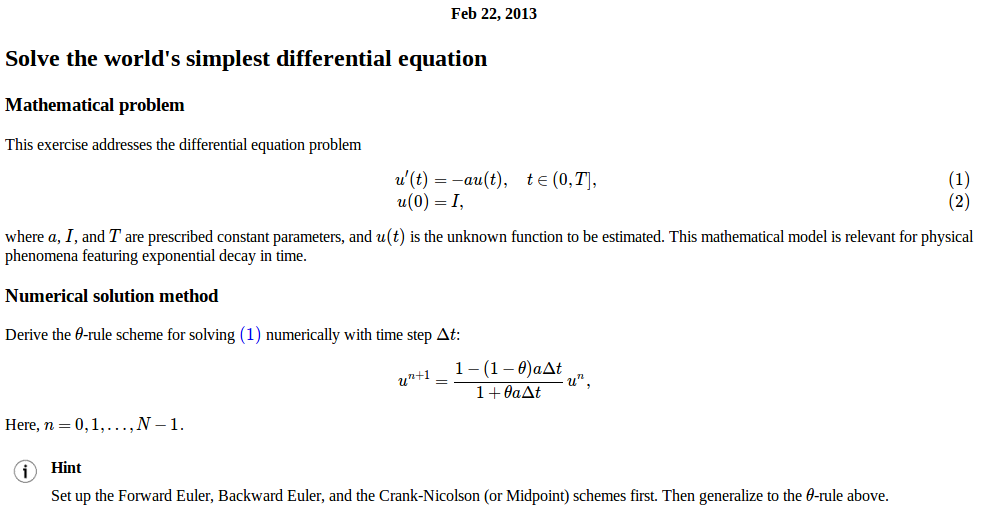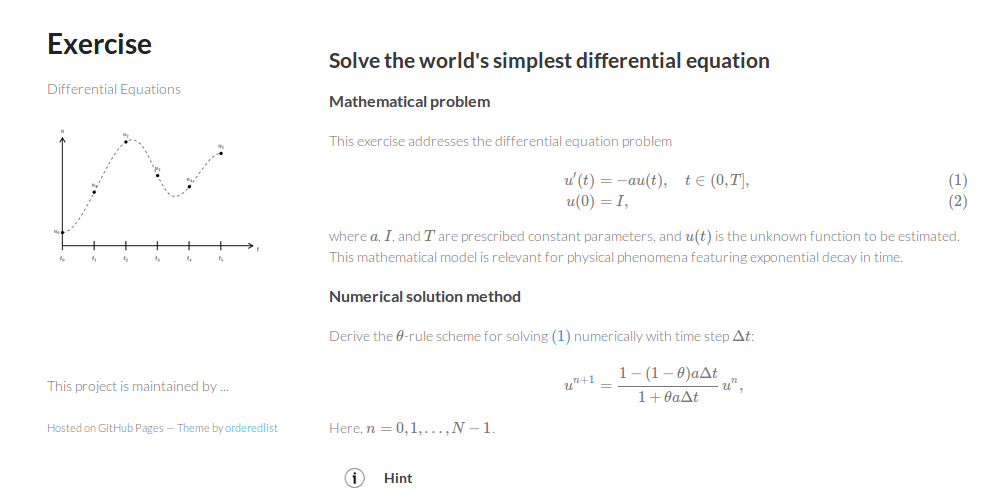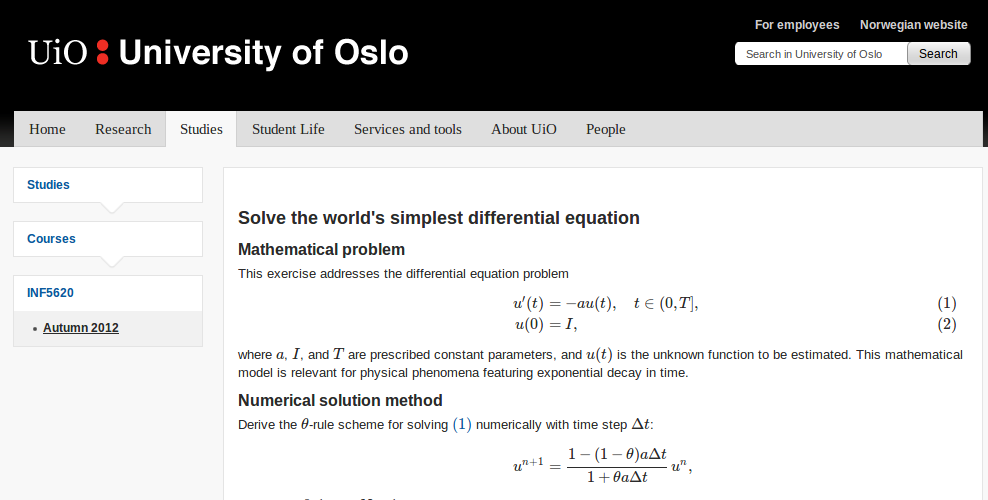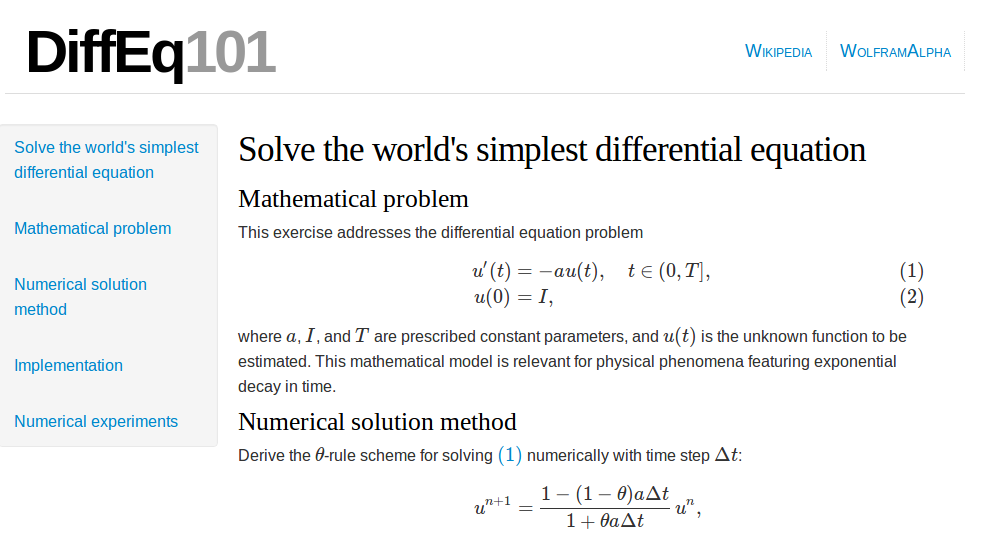Wrapping Plain HTML Files in Fancy Design Templates
Mar 15, 2015
Summary. You want to write your web pages as simple text, but at the same time you need the design and layout to be compatible with a given look-and-feel standard. This is easy to accomplish by writing the HTML pages in plain DocOnce text and using HTML templates. The present note explains the details.
Example on a problem setting
- You need to write web pages, say for a course, and want to have complete control of the core text in a plain text editor without paying attention to fancy layouts.
- There might be many pages, often developing dynamically over time, linked to a potentially large number of files (images, computer codes, lecture notes, exercises, etc.). This author also has a lot of mathematics and computer code in these pages.
- You will (of course) have full version control of the files with the core content and publish the latest version of all files with one command.
- However, the web pages should appear with a prescribed look and feel because your host institution requires so.
- The look and feel is automatically obtained if you write your web pages with particular web-based tools, but this tedious and boring, happens without version control, has no support for nicely typeset mathematics and computer code, and most importantly: the approach does not scale with a lot of files!
- You would like your pages to live on a 24/7 available server you have chosen, e.g., GitHub, Bitbucket, Googlecode, or similar.
Solution
Step 1: Use DocOnce to generate text
We shall in this document use DocOnce for writing the core text. DocOnce looks like plain text, with just a few tags for enabling full LaTeX mathematics and nicely typeset computer code. From DocOnce you can go to plain LaTeX, pdfLaTeX, Sphinx, HTML, Markdown, and MediaWiki, to mention some good formats that support LaTeX mathematics and nice computer code. (If you do not have code and math, it is easy to go to MS Word, XML, DocBook, and numerous other formats too.) From a DocOnce text it is also trivial to generate slides.
Step 2: Write the core text
Write the core text, here an exercise with some math and code stored in a file mydoc.do.txt:
DATE: today
======= Solve the world's simplest differential equation =======
===== Mathematical problem =====
This exercise addresses the differential equation problem
!bt
\begin{align}
u'(t) &= -au(t), \quad t \in (0,T], label{ode}\\
u(0) &= I, label{initial:value}
\end{align}
!et
where $a$, $I$, and $T$ are prescribed constant parameters, and $u(t)$ is
the unknown function to be estimated. This mathematical model
is relevant for physical phenomena featuring exponential decay
in time.
===== Numerical solution method =====
Derive the $\theta$-rule scheme for solving \eqref{ode} numerically
with time step $\Delta t$:
!bt
\[
u^{n+1} = \frac{1 - (1-\theta) a\Delta t}{1 + \theta a\Delta t}u^n,
\]
!et
Here, $n=0,1,\ldots,N-1$.
Hint.\n
Set up the Forward Euler, Backward Euler, and the Crank-Nicolson (or
Midpoint) schemes first. Then generalize to the $\theta$-rule above.
===== Implementation =====
The numerical method is implemented in a Python function
`solver` (found in the "`decay_mod`":
"https://github.com/hplgit/INF5620/tree/gh-pages/src/decay/experiments/decay_mod.py" module):
!bc pycod
from numpy import linspace, zeros
def solver(I, a, T, dt, theta):
"""Solve u'=-a*u, u(0)=I, for t in (0,T] with steps of dt."""
dt = float(dt) # avoid integer division
N = int(round(T/dt)) # no of time intervals
T = N*dt # adjust T to fit time step dt
u = zeros(N+1) # array of u[n] values
t = linspace(0, T, N+1) # time mesh
u[0] = I # assign initial condition
for n in range(0, N): # n=0,1,...,N-1
u[n+1] = (1 - (1-theta)*a*dt)/(1 + theta*dt*a)*u[n]
return u, t
!ec
===== Numerical experiments =====
Fix the values of where $I$, $a$, and $T$.
Then vary $\Delta t$ for $\theta=0,1/2,1$.
Illustrate that if $\Delta t$ is not sufficiently small,
$\theta=0$ and $\theta=1/2$ can give non-physical solutions
(more precisely, oscillating solutions).
Perform experiments and determine empirically the convergence
rate for $\theta=0,1/2,1$.
When the title in a DocOnce document (TITLE: ...) is missing or
commented out (#TITLE:), no HTML header and footer are generated,
which is important when embedding the HTML code in a template file
later.
Step 3: Inspect the HTML page
Check the default layout of your HTML page by translating the DocOnce file to HTML:
doconce format html mydoc
google-chrome mydoc.html
The page is rendered with the default HTML style as seen in the figure below (or in the file itself):

Step 4: Find some web page and make a template
When you see a design of a web page that you would like to adopt, view the source code (all browsers have a menu choice for doing this) and store it on file. To proceed you need to know some basic HTML.
- Identify where the main body of text is. Remove this text and
insert
%(main)sinstead. This is a tag that will be replaced by the HTML code of the core text you had inmydoc.do.txt. (The HTML code of the web page is viewed as a text string in Python and%(main)sis just the standard syntax for inserting a dictionary with keymainat this point.) - Identify the
titletag and replace the title by%(title)s. The title (commented out) or the first heading inmydoc.do.txtwill replace%(title)s. - If relevant, find the date in the page and replace by
%(date)s. - Search for text
link type="text/css" rel="stylesheet"..., which specifies CSS stylesheets. You either need to have the stylesheet files together with the HTML document, or you need to copy the stylesheet code into the HTML file. - Search for text
script type="text/javascript" src="..., which specifies JavaScript code. Either the code must be available on the net (http://...address) or you need a copy of this code stored along with the HTML file. You may use the Google Chrome or Firefox browsers to view the source code and just click on stylesheets, JavaScript files, and other links to see the content. This has the great advantage of showing a complete URL to the file that may have a relative path in the HTML code.
<!doctype html>
<html>
<head>
<meta charset="utf-8">
<meta http-equiv="X-UA-Compatible" content="chrome=1">
<title>%(title)s</title>
<link rel="stylesheet" href="css/styles.css">
<meta name="viewport"
content="width=device-width, initial-scale=1, user-scalable=no">
</head>
<body>
<div class="wrapper">
<header>
<h1>Main Permanent Header</h1>
<p>Permanent SubHeader</p>
<!-- picture below the heading on the left -->
<img src="..." width=220>
</header>
<!-- Here goes the main page --->
<section>
%(main)s
</section>
<footer>
<p>This project is maintained by ...</p>
<p><small>Hosted on GitHub Pages — Theme by
<a href="https://github.com/orderedlist">orderedlist</a>
</small></p>
</footer>
</div>
<script src="js/scale.fix.js"></script>
</body>
</html>
Note that the template requires
- the stylesheet
styles.cssin a subdirectorycss - the JavaScript
scale.fix.jsin a subdirectoryjs
- The picture on the left is specified to
fig/discrete_function.pngwhich acts as a kind of logo for the page. - The
Main Permanent HeaderandPermanent SubHeaderare replaced by something appropriate, hereExerciseandDifferential Equations.
Step 5: Embed your HTML document in the template
We can now use DocOnce to insert our document mydoc.html,
generated from mydoc.do.txt into an HTML template.
The template shown above, stored in the file template_minimal.html
is used as example. We run
doconce format html mydoc --html_template=template_minimal.html
The result is a file mydoc.html where
- the first heading in
mydoc.do.txtis substituted as title tag - the text in
mydoc.do.txt, transformed to HTML, is inserted where%(main)sappears in the template.

The original text file mydoc.do.txt has now been transformed
to a web page with fancy design!
Making a template from Vortex pages at the University of Oslo
As another example, we want to make web pages that has the look and feel of the Vortex web system at the University of Oslo. Let us look at a specific course from the official web pages. The associated HTML source code is huge. Here is a glimpse:
<link type="text/css" rel="stylesheet" media="all" href="/vrtx/decorating/resources/dist/style/style.css" />
<link type="text/css" rel="stylesheet" media="all" href="/vrtx/decorating/resources/dist/www.uio.no/logos-eng/logos.css" />
<link type="text/css" rel="stylesheet" media="print" href="/vrtx/decorating/resources/dist/style/print.css" />
<link type="text/css" rel="stylesheet" media="handheld" href="/vrtx/decorating/resources/dist/style/handheld.css"/>
<script type="text/javascript" src="/vrtx/__vrtx/static-resources/jquery/jquery.min.js"></script>
...
<!-- Page header end -->
<div id="uiodoc-wrapper">
<div id="uiodoc">
<!-- img-tag for print -->
<img id="head-print" alt="print logo" src="/vrtx/decorating/resources/dist/www.uio.no/logos-eng/faculty-small.png"/>
...
<div id="right-main">
<!--startindex-->
Our aim is to make a template out of this file by keeping header, footer,
style information, links, etc., which are common to all web pages, and
replacing the course-specific information, title, and date by
"slots" like %(main)s, %(title)s, and %(date)s.
We do the following:
- The part of the text which we want to replace by our course-specific
plain text must be deleted and substituted by
%(main)s. - A more challenging task is to deal with all the links to local files
of the type
/vrtx/decorating/resources/...and similar. However, clicking on these links when viewing the source code of the page in Google Chrome or Firefox, displays the full URL of the files. It appears that/vrtx/can simply be replaced byhttp://www.uio.no/vrtx/and the page works (!). We therefore carry out that substitution. - The title inside the
titletags is replaced by%(title)s.
%(date)s.)
The "resulting code": "uio/template_5620_pygmentized.hml" is ready
as a template:
doconce format html mydoc --html_template=mynewcoursetemplate.html
Here is the result.

It really looks that we are inside the Vortex web system at the University of Oslo and all the links to Student Life, People, etc. work.
Normally, the web pages at the University of Oslo have to be written through a web-based editor (in the Vortex system), and the information is stored in XML files. It is somewhat remarkable that the HTML rendered from these XML files can be copied so easily and used as templates for web documents anywhere else.
Using the Vagrant template
Besides the GitHub "minimal" theme, DocOnce comes with a template template_vagrant.html adopted from the style in the original documentation of the Vagrant virtual machine tool.

This template is easy to adopt to a particular set of web pages. The plain template looks as

There are several elements in the template:
- Navigation bar to the left, which is automatically created by DocOnce.
- A main part (
%(main)s) and a title as usual. - Navigation buttons on the button, which are automatically filled in by DocOnce if the document is split into several parts.
- A logo consisting of a LogoWord in black and a withSubWord in gray. This should be manually edited to some short name for the web pages you want to embed with the Vagrant style.
- Navigation links in the top right part of the page. These should be manually edited or deleted.
- At the bottom of the page there is a footer, which can be manually edited or deleted.
Translation of the original DocOnce writings in mydoc.do.txt is
done by
doconce format html mydoc.do.txt --html_style=bootstrap \
--html_template=template_vagrant.html
The resulting HTML file has a nice look:

Summary
We have seen have to write web pages in a text-like format, with full support of LaTeX mathematics and nicely typeset (pygmentized) computer code. These pages can easily be embedded in various fancy HTML styles by simply grabbing a web page with the desired style and editing it as explained to make an HTML template. DocOnce can then embed our plain text in the template.
However, embedding DocOnce documents in fancy web pages is just one technique to achive nice web designs. DocOnce features Bootstrap and Sphinx HTML styles, which offer a lot of different designs, see our Bootstrap demo and our extensive report demo.